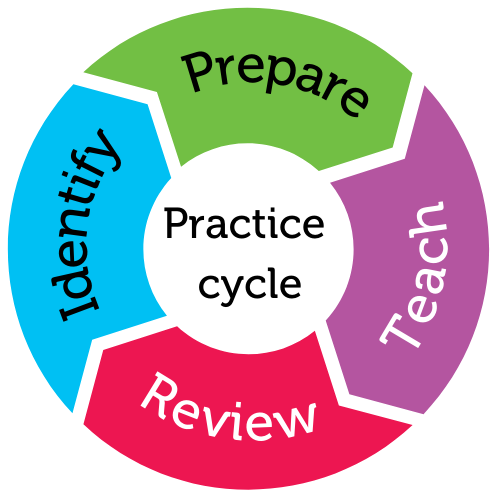
For student year
Helps students to
- engage in tasks
- self-regulate
Helps teachers to
- make adjustments
- support sensory needs
Summary
For the secondary school version of this practice, go to:
Meet students' sensory needs (Years 7 to 12)
Students learn best in inclusive classrooms that consider everyone's needs, including students' sensory preferences. Of course, it’s difficult to cater to every preference, but there are adjustments you can make to keep sensory stimuli at a level that allows your students to feel comfortable, focussed, and safe. Observe and get to know your students and their sensory preferences so you can create a more effective learning environment in whatever space you're in.
Students on the autism spectrum often have specific sensory needs that, when met, can help them self-regulate and engage more readily. Making adjustments to accommodate these needs also supports behaviour management, ensuring teaching and learning is productive for everyone.
"Sensory needs which are not met in the classroom environment can be particularly challenging for the student and can sometimes present as inattentiveness, meltdowns and inappropriate behaviour"
How the practice works
Watch this video to learn more about sensory needs.
Duration: 2:46
Australian Professional Standards for Teachers related to this practice
1.1 - physical, social and intellectual development and characteristics of students
1.5 - differentiate teaching to meet the specific learning needs of students across the full range of abilities
1.6 - strategies to support full participation of students with disability
For further information, see Australian Professional Standards for Teachers AITSL page
Preparing to teach
Observe student behaviour
Sensory processing differences can present a variety of challenges for neurodivergent students. These students may have difficulty processing information, paying attention or sitting still for extended periods, writing, responding to questions, keeping organised, and staying regulated.
Students with sensory processing differences may have sensory needs relating to:
- hearing (auditory)
- seeing (visual)
- feeling (tactile, touch, temperature, body awareness)
- smelling (olfactory)
- taste (gustatory)
- vestibular (related to balance/movement)
- interoception (related to internal body signals such as pain and hunger) and
- proprioception (related to awareness of body position)
These needs are highly unique to the individual, and can change depending on the time of day, environment, or current levels of sensory input.
Some students are:
- hypersensitive: they experience overwhelmingly more sensory input than others, e.g., lights may seem too bright or noises too loud. This can result in sensory avoidance behaviour (trying to get away from this sensory input).
- hyposensitive: they are much less responsive to particular sensations and need more of that sensory stimulus to recognise the sensation and/or feel comfortable, e.g., dislike quiet spaces and prefer listening to music to concentrate. This can result in sensory seeking behaviour (trying to get more sensory input from the environment).
Consult with students, families, and specialists
Sensory needs vary from person to person. Consulting with students, parents/carers, and specialists such as therapists will help you to:
- identify appropriate sensory supports
- gain advice on a range of adjustments and supports.
It works better if:
- the teacher asks for input from the student, parents/carers, and specialists around the student’s sensory supports.
It doesn't work if:
- the teacher guesses what sensory support might be useful for the student without consultation
- the teacher removes sensory supports to punish the student.
In the classroom
How do I do it?
How do I meet students’ sensory needs?
- identify students who may benefit from sensory support
- identify sensory processing differences that may be affecting a student’s behaviour, learning, and engagement. Consult with the student, their family, and relevant specialists about what sensory needs the student has, and what support may help them.
- implement the necessary adjustments.
- observe the student and review the efficacy of the adjustment, altering if necessary.
Potential adjustments for the classroom
Adjustments for hypersensitive sensory processing include:
- using a filter or light covers, dimmable lights or turning off a bank of lights in the classroom
- allowing students to wear a hat or sunglasses inside if the lights are unable to be changed
- offering noise-cancelling headphones in noisy environments
- offering a variety of seating options, if students prefer to sit somewhere where they won’t be touched
- offering a quiet, dark sensory-free space for the student to self-regulate.
Adjustments for hyposensitive sensory processing include:
- using visual supports to explain verbal directions
- allowing or offering fidget toys, chewies or other sensory tools (note: you can explain that these are a tool to help focus, not a toy to be played with, and ensure that they are not noisy so as to distract others)
- offering headphones so students can listen to music while they work
- create a sensory space with different tactile items
How will I know if it's working?
The student will appear more focused and on task for greater periods of time and demonstrate less frequent challenging behaviours and meltdowns.
Practice toolkit
Practice implementation planner template
We know it's not always easy to keep track of what's working and what isn't. So, we've created this template for you to record and reflect on what you're doing to create more inclusive classrooms. The implementation planner contains:
- guidance around goal setting
- a reflection section (what worked, didn’t work, what to change, and next steps)
- prompting questions.
Implementation planner with examples
Set your professional learning goal for:
Meet students' sensory needs
Benefits of goal setting
Setting, working towards, and reflecting on goals helps you grow professionally and improve your practice. You can access AITSL learning resources for teachers to learn more about:How to set goals
The Australian Institute for Teaching and School Leadership recommends using the SMART matrix to frame your goal setting.SMART goals refers to goals that are:
- Specific
- Measurable
- Achievable
- Relevant
- Time-phased
Resources
Meet students' sensory needs - Practice Brief
Sensory Audit Checklist - Primary
Use this simple Sensory Audit Checklist for primary teachers in your own or new classrooms to ensure an optimal sensory learning space.
Explanatory video: Sensory overload
Related Practices

Improve your classroom's acoustics
TEACHING PRACTICE
For student years
Helps students to
- hear in the classroom

Meet students' sensory needs (Secondary)
TEACHING PRACTICE
For student years
Helps students to
- engage in tasks
- self-regulate
This practice is from the core research project
Learning Cycle

Set your practice implementation goal
Evidence
This practice was developed as part of the Models of practice project. More information about the evidence informing this practice is available on the project page.
